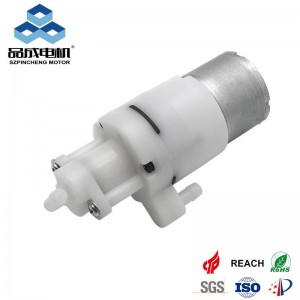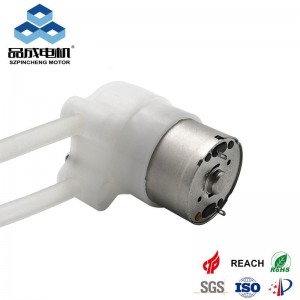Mini diaphragm pumps are widely used in various industries due to their compact size, simple structure, and reliable performance. In the medical field, they play a crucial role in devices like dialysis machines, ensuring the precise and safe transfer of fluids for patients' treatment. In environmental monitoring, these pumps are utilized in water and air sampling equipment, where their accurate and consistent operation is essential for collecting representative samples to assess pollution levels. In industrial settings, they are employed in processes such as chemical dosing, where the ability to handle different fluids with precision is highly valued. In scientific research, mini diaphragm pumps are often found in laboratory equipment for tasks like liquid chromatography, contributig to accurate experimental results. However, like any other mechanical equipment, they may encounter problems during operation, and leakage is one of the most common issues. This article will analyze the causes of leakage in mini diaphragm pumps and propose corresponding solutions to help you effectively address this problem and improve the performance and lifespan of the pump.
Common Causes of Leakage in Mini Diaphragm Pumps
Diaphragm Aging and Wear
The diaphragm is a key component of the mini diaphragm pump. After long - term use, the diaphragm, usually made of rubber or plastic materials, is prone to aging and wear. The continuous reciprocating motion of the diaphragm under the action of mechanical stress and the chemical corrosion of the conveyed medium accelerate this process. Once the diaphragm shows signs of aging, such as cracking, hardening, or thinning, it will lose its sealing function, resulting in leakage. For example, in a mini diaphragm pump used in a chemical laboratory to transfer weak acidic solutions, after about six months of continuous use, the rubber diaphragm began to show small cracks, which eventually led to leakage.
Improper Installation
The installation quality of the mini diaphragm pump has a significant impact on its sealing performance. If the diaphragm is not correctly installed during the assembly process, for instance, if it is not centered in the pump chamber or the connection parts are not tightly fastened, it will cause uneven stress on the diaphragm during the pump's operation. This uneven stress can cause the diaphragm to deform, and over time, it will lead to leakage. In addition, if the pump body and pipeline are not thoroughly cleaned before installation, residual impurities and particles may scratch the diaphragm surface, reducing its sealing ability.
Corrosion of the Conveyed Medium
In some applications, mini diaphragm pumps need to transport corrosive media, such as acids, alkalis, and certain organic solvents. These corrosive substances can react chemically with the diaphragm material, gradually eroding the diaphragm and causing it to develop holes or cracks. Different materials have different degrees of resistance to corrosion. For example, a fluoroplastic diaphragm has better chemical resistance than a common rubber diaphragm. When a mini diaphragm pump equipped with a rubber diaphragm is used to transport a high - concentration salt solution for a long time, the diaphragm may be severely corroded within a few weeks, leading to leakage.
High - Pressure and High - Temperature Working Conditions
Mini diaphragm pumps operating under high - pressure or high - temperature conditions are more likely to experience leakage problems. High - pressure environments increase the stress on the diaphragm, exceeding its design pressure tolerance, which may cause the diaphragm to rupture. High - temperature conditions can accelerate the aging process of the diaphragm material, reducing its mechanical properties and sealing performance. In industrial processes such as steam - assisted chemical reactions, where the mini diaphragm pump needs to transport hot and high - pressure fluids, the probability of leakage is relatively high.
Effective Solutions to Leakage Problems
Regular Diaphragm Replacement
To prevent leakage caused by diaphragm aging and wear, it is essential to establish a regular diaphragm replacement schedule. The replacement interval should be determined based on the actual working conditions of the pump, such as the type of conveyed medium, operating frequency, and working environment. For general applications with non - corrosive media, the diaphragm can be replaced every 3 - 6 months. In more harsh environments, such as when transporting corrosive media, the replacement interval may need to be shortened to 1 - 3 months. When replacing the diaphragm, it is necessary to select a diaphragm with the correct model, size, and material to ensure a perfect fit with the pump. For example, if the original diaphragm is made of natural rubber and is used in a slightly acidic environment, it can be replaced with a neoprene diaphragm, which has better acid resistance.
Standard Installation Procedures
During the installation of the mini diaphragm pump, it is necessary to follow strict and standard procedures. First, thoroughly clean the pump body, diaphragm, and all connection parts to ensure that there are no impurities or particles. When installing the diaphragm, carefully align it with the pump chamber to ensure that it is evenly stressed during operation. Use appropriate tools to tightly fasten all connection parts, but avoid over - tightening, which may damage the parts. After installation, conduct a comprehensive inspection, including visual inspection of the diaphragm's installation position and a pressure test to check for any potential leakage points. A simple pressure test can be carried out by connecting the pump to a closed water - filled pipeline and gradually increasing the pressure to the normal operating pressure of the pump while observing for any signs of leakage.
Selection of Appropriate Materials
When choosing a mini diaphragm pump for applications involving corrosive media, it is crucial to select a pump with a diaphragm made of corrosion - resistant materials. As mentioned earlier, fluoroplastic diaphragms are highly resistant to a wide range of corrosive substances and are suitable for use in strong acid and alkali environments. In addition to the diaphragm, other parts of the pump in contact with the medium, such as the pump body and valves, should also be made of corrosion - resistant materials. For example, if the pump is used to transport a concentrated sulfuric acid solution, the pump body can be made of stainless steel 316L, which has good resistance to sulfuric acid corrosion.
Optimization of Working Conditions
If possible, try to optimize the working conditions of the mini diaphragm pump to reduce the occurrence of leakage. For high - pressure applications, consider installing a pressure - reducing valve in the pipeline to ensure that the pressure acting on the pump is within its rated range. In high - temperature environments, take appropriate cooling measures, such as installing a heat exchanger or increasing the ventilation around the pump. This can effectively reduce the temperature of the pump and the conveyed medium, slowing down the aging of the diaphragm. For example, in a pharmaceutical production line where the mini diaphragm pump is used to transport a heat - sensitive liquid at high temperature, an air - cooled heat exchanger can be installed in the pipeline to cool the liquid before it enters the pump.
Conclusion
Leakage in mini diaphragm pumps can be caused by multiple factors, including diaphragm aging, improper installation, medium corrosion, and harsh working conditions. By understanding these causes and implementing corresponding solutions, such as regular diaphragm replacement, following standard installation procedures, choosing appropriate materials, and optimizing working conditions, the leakage problem can be effectively resolved. This not only ensures the normal operation of the mini diaphragm pump but also extends its service life, reducing maintenance costs and improving production efficiency. If you encounter any problems with mini diaphragm pumps that you cannot solve on your own, it is recommended to consult professional technicians or the pump manufacturer for assistance.n




